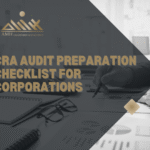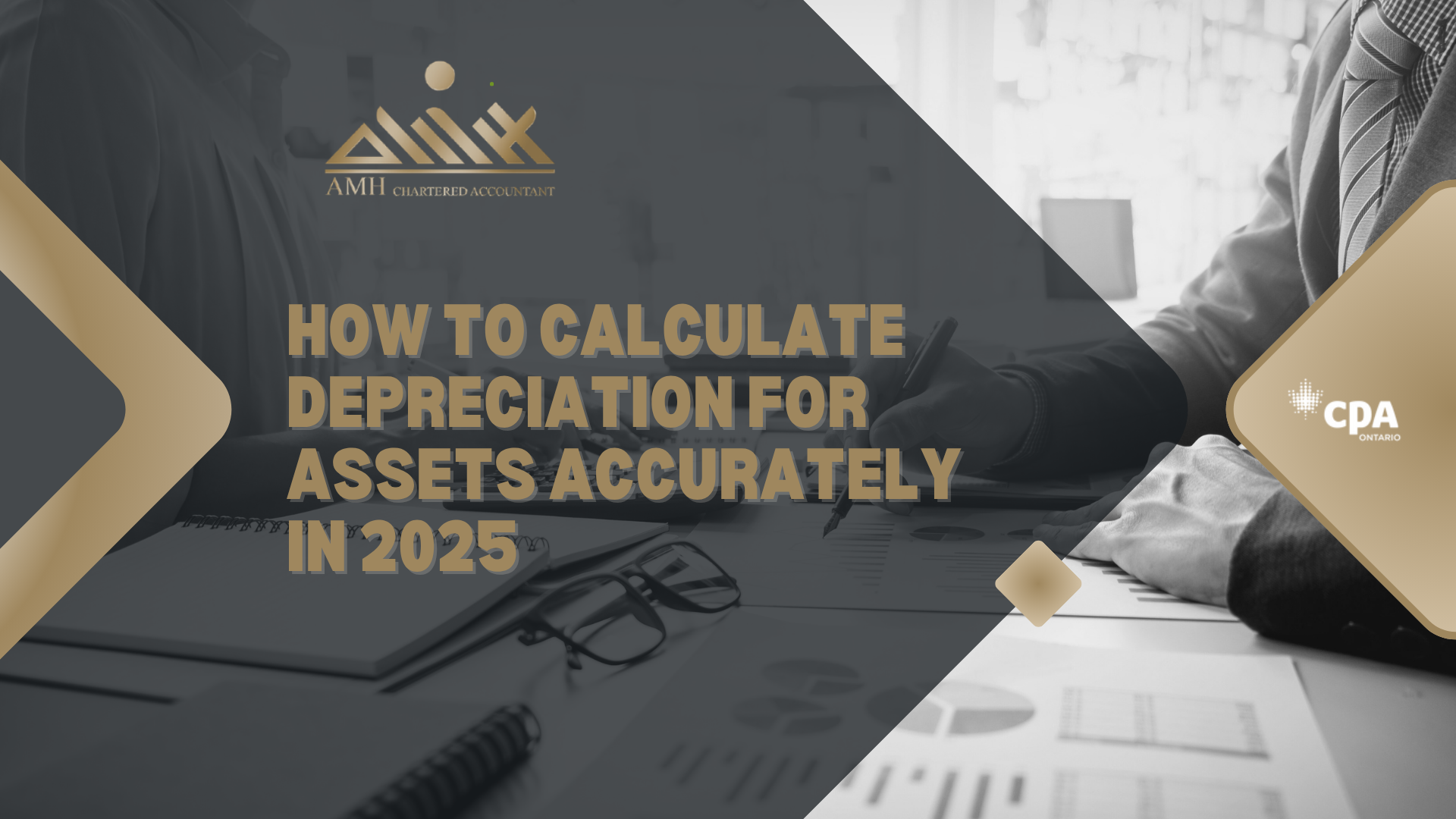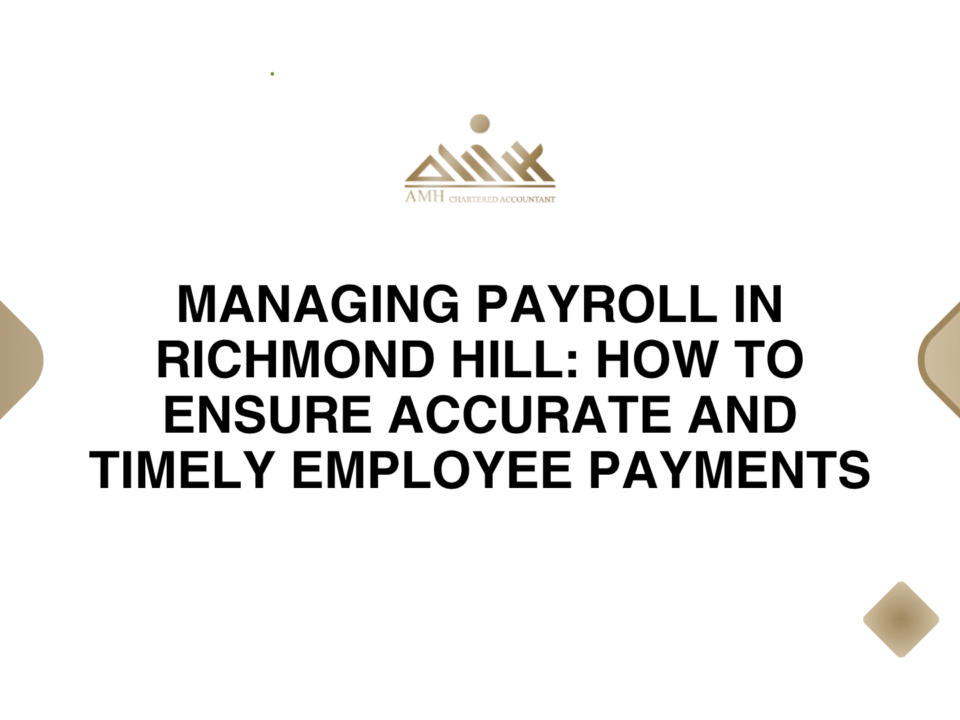
Early Warning Signs in Your Financials That Could Signal a Cash Crisis
July 15, 2025
CRA Audit Preparation Checklist for Corporations
July 25, 2025How to Calculate Depreciation for Assets Accurately in 2025
Calculating depreciation accurately is essential for maintaining accurate financial records, reducing tax liabilities, and understanding the true value of your assets. In this article, AMH Chartered Professional Accountant explains how to calculate depreciation in 2025, ensuring your business stays compliant with current standards and regulations.
Introduction: Understanding Depreciation and Its Importance
Depreciation is a key concept in accounting that affects the financial statements of businesses. In simple terms, depreciation represents the reduction in value of tangible fixed assets over time due to usage, wear and tear, or obsolescence. For businesses, accurately calculating depreciation is essential for tax purposes, ensuring compliance, and providing a realistic representation of asset value on the balance sheet.
With 2025 bringing new accounting regulations and technologies, understanding how to calculate depreciation has become even more important. At AMH Chartered Professional Accountant, we help businesses in Toronto, Milton, Oakville, Hamilton, Kitchener, and Waterloo accurately calculate depreciation, ensuring your financial records are precise and compliant.
What is Depreciation?
Depreciation refers to the systematic allocation of the cost of a tangible asset over its useful life. Rather than recording the full expense of an asset upfront, depreciation allows businesses to spread the cost over the asset’s estimated lifespan. This process helps businesses reflect the true cost of using the asset and allocate expenses more accurately over time.
For example, if a company purchases machinery for $100,000 with an expected useful life of 10 years, depreciation allows the company to deduct a portion of the asset’s cost each year instead of deducting the full $100,000 in the first year.
Different Methods of Depreciation
There are several methods used to calculate depreciation, each suitable for different types of assets and business needs. The choice of method will depend on factors such as the asset’s expected use, the business’s financial strategy, and tax considerations. The most common methods are:
Straight-Line Depreciation: The asset’s cost is spread evenly over its useful life.
Declining Balance Depreciation: Depreciation is higher in the early years and decreases over time.
Units of Production Depreciation: Depreciation is based on the asset’s usage or output, making it ideal for manufacturing equipment.
Each method has its advantages and should be chosen based on the asset’s characteristics and the company’s financial goals.
Choosing the Right Depreciation Method for Your Business
Selecting the right depreciation method depends on various factors, such as:
Nature of the Asset: Does the asset lose value steadily over time, or does it lose value more rapidly in the initial years?
Tax Strategy: Some methods, like declining balance depreciation, may allow for higher deductions in the early years, which can be advantageous for businesses looking to minimize taxable income.
Financial Reporting: If your company needs to present consistent financial results, straight-line depreciation may provide more stability in your balance sheets.
AMH Chartered Professional Accountant can help you determine the most beneficial depreciation method based on your business’s unique circumstances.
Step 1: Identifying Depreciable Assets
The first step in calculating depreciation is identifying which assets qualify for depreciation. Not all assets are depreciable. The asset must be:
Tangible: Depreciation applies only to physical assets like buildings, machinery, vehicles, and equipment.
Used in Business: The asset must be used for business purposes and not for personal use.
Have a Finite Life: Assets with an indefinite lifespan, such as land, are not depreciable.
Not Intended for Resale: Assets purchased for resale, such as inventory, cannot be depreciated.
Once you’ve identified the depreciable assets, you’ll need to gather key information, such as the asset’s purchase cost, expected useful life, and residual value.
Step 2: Determining the Useful Life of the Asset
The useful life of an asset is the period over which the asset is expected to be used by the business before it becomes obsolete or no longer functional. Determining the useful life is critical for calculating depreciation because it impacts how much depreciation expense will be recorded each year.
Guidelines for determining useful life:
IRS or CRA Guidelines: For tax purposes, the Canada Revenue Agency (CRA) provides useful life guidelines for different types of assets.
Industry Standards: Common industry practices can help estimate the useful life of specific assets.
Manufacturer Estimates: For some assets, the manufacturer will provide a recommended useful life.
Step 3: Estimating the Residual Value
The residual value (or salvage value) is the estimated amount the asset will be worth at the end of its useful life. This amount is subtracted from the purchase cost when calculating depreciation. The residual value represents the expected resale or scrap value of the asset.
For example, if an asset is purchased for $50,000 and its estimated residual value is $5,000, the total depreciable amount would be $45,000. The asset will depreciate over its useful life, but you will never depreciate it beyond its residual value.
Step 4: Applying Depreciation Methods
Once you’ve gathered the necessary information, you can apply the chosen depreciation method. Here’s an overview of how to apply each method:
Straight-Line Depreciation: Simplified Calculation
This method is the simplest and most commonly used. Under the straight-line method, the asset’s depreciation is the same every year. The formula is:
Annual Depreciation Expense = (Cost of Asset – Residual Value) / Useful Life
For example, if an asset costs $100,000, has a residual value of $10,000, and a useful life of 10 years, the annual depreciation expense will be:
($100,000 – $10,000) / 10 = $9,000 per year
Declining Balance Method: Accelerating Depreciation
The declining balance method results in higher depreciation expenses in the earlier years of the asset’s useful life. This method is useful for assets that lose value quickly. The formula is:
Annual Depreciation Expense = Book Value at Beginning of Year × Depreciation Rate
For example, if you choose a 30% depreciation rate for an asset worth $100,000, the first year’s depreciation would be:
$100,000 × 30% = $30,000
In the second year, the depreciation will be calculated on the new book value (after subtracting the first year’s depreciation).
Units of Production Method: Useful for Manufacturing Assets
This method bases depreciation on the asset’s usage or output, making it ideal for machinery or equipment used in production. The formula is:
Depreciation Expense = (Cost of Asset – Residual Value) / Total Expected Output × Actual Output for the Year
This method ensures that assets used more frequently are depreciated more quickly.
Special Considerations in Depreciation Calculations for 2025
As accounting standards evolve, businesses need to be aware of any changes in tax laws, depreciation rates, and methods. For 2025, be aware of the following changes:
New Asset Categories: Certain asset categories may see changes in their depreciation schedules or tax treatment.
Tax Law Changes: Updates to tax regulations could affect how businesses claim depreciation or may introduce new incentives for capital investments.
Digital Assets: With the rise of digital technology, businesses may need to consider how to account for intangible assets like software, patents, and copyrights, which are subject to different depreciation rules.
Always consult with a tax professional or accountant, like those at AMH Chartered Professional Accountant, to stay up to date on these changes.
Tax Implications of Depreciation in Canada
Depreciation can have significant tax implications. By calculating depreciation, businesses reduce their taxable income, leading to potential tax savings. However, it’s important to follow CRA guidelines on depreciation, especially for assets used for both business and personal purposes.
Tax Considerations:
Capital Cost Allowance (CCA): In Canada, businesses use the CCA system to calculate depreciation for tax purposes. The CRA provides different depreciation classes for various asset types, each with its own rate.
Tax Deferrals: Depreciation allows businesses to defer taxes on capital expenditures, freeing up cash flow for reinvestment in the business.
How AMH Chartered Professional Accountant Can Help with Depreciation Calculations
At AMH Chartered Professional Accountant, we specialize in providing businesses with accurate and timely depreciation calculations. Our services include:
Accurate Depreciation Schedules: We calculate depreciation for all of your business assets using the most appropriate methods.
Tax Planning and Compliance: We ensure that your depreciation calculations are in line with CRA regulations and help maximize tax savings.
Software Integration: We use advanced accounting software to automate depreciation tracking and reporting, ensuring accuracy and efficiency.
Common Mistakes to Avoid When Calculating Depreciation
Misclassifying Assets: Ensure that only tangible assets are depreciated.
Incorrect Residual Value: Be realistic when estimating the residual value of your assets.
Failing to Track Changes in Asset Use: Monitor the actual use of assets to determine if a change in depreciation method is needed.
Neglecting to Update Depreciation Schedules: As assets age, their depreciation schedules may need to be updated.
Best Practices for Ongoing Payroll Management
Review Asset Value Regularly: Assess the actual condition of assets periodically to ensure accurate depreciation.
Use Accounting Software: Automate depreciation calculations using software like QuickBooks or Xero to ensure precision and minimize errors.
Consult with Professionals: For complex assets or tax planning, consult with an accountant or tax professional to optimize depreciation.
The Future of Depreciation Calculations: Trends and Changes
As technology advances, the depreciation calculation process will continue to evolve. Automation, cloud-based tools, and AI are likely to play a larger role in making depreciation calculations more accurate and efficient. Additionally, businesses can expect new tax laws that may impact how assets are treated for both financial reporting and tax purposes.
Conclusion: Ensuring Accurate Depreciation Calculations in 2025
Accurate depreciation calculations are vital for financial reporting, tax compliance, and business planning. By understanding the different depreciation methods and following best practices, businesses can ensure that their financial statements are precise, taxes are optimized, and assets are managed efficiently.
At AMH Chartered Professional Accountant, we are committed to helping businesses accurately calculate and manage depreciation in line with current tax regulations, ensuring that your business stays compliant and financially sound in 2025 and beyond.
FAQs
How do I choose the right depreciation method?
The right method depends on the nature of the asset and your business’s financial goals. Straight-line is ideal for long-lasting assets, while declining balance works for assets that lose value quickly.
What is the Canada Revenue Agency’s Capital Cost Allowance (CCA)?
The CCA is the tax system used in Canada to determine how businesses can deduct depreciation on capital assets. Each asset is assigned to a specific class with its own depreciation rate.
Can I change my depreciation method?
Yes, but changes must be made in accordance with accounting standards and tax regulations. It’s recommended to consult a professional before making any changes.
How does depreciation affect my business’s tax liabilities?
Depreciation can reduce taxable income, leading to lower tax liabilities and freeing up cash flow for other investments.




